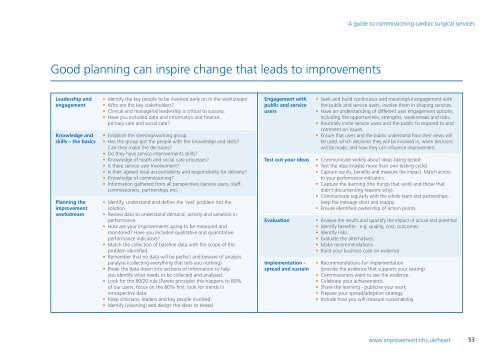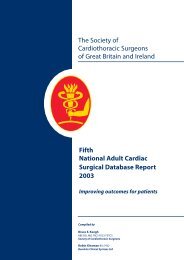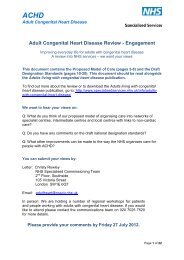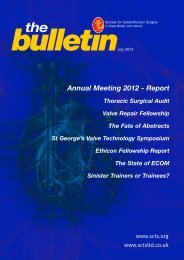A guide to commissioning cardiac surgical services - NHS ...
A guide to commissioning cardiac surgical services - NHS ...
A guide to commissioning cardiac surgical services - NHS ...
You also want an ePaper? Increase the reach of your titles
YUMPU automatically turns print PDFs into web optimized ePapers that Google loves.
A <strong>guide</strong> <strong>to</strong> <strong>commissioning</strong> <strong>cardiac</strong> <strong>surgical</strong> <strong>services</strong><br />
Good planning can inspire change that leads <strong>to</strong> improvements<br />
Leadership and<br />
engagement<br />
Knowledge and<br />
skills – the basics<br />
Planning the<br />
improvement<br />
workstream<br />
• Identify the key people <strong>to</strong> be involved early on in the workstream.<br />
• Who are the key stakeholders?<br />
• Clinical and managerial leadership is critical <strong>to</strong> success.<br />
• Have you included data and informatics and finance,<br />
primary care and social care?<br />
• Establish the steering/working group.<br />
• Has the group got the people with the knowledge and skills?<br />
Can they make the decisions?<br />
• Do they have service improvements skills?<br />
• Knowledge of heath and social care processes?<br />
• Is there service user Involvement?<br />
• Is their agreed local accountability and responsibility for delivery?<br />
• Knowledge of <strong>commissioning</strong>?<br />
• Information gathered from all perspectives (service users, staff,<br />
commissioners, partnerships etc).<br />
• Identify, understand and define the ‘real’ problem not the<br />
solution.<br />
• Review data <strong>to</strong> understand demand, activity and variation in<br />
performance.<br />
• How are your improvements going <strong>to</strong> be measured and<br />
moni<strong>to</strong>red? Have you included qualitative and quantitative<br />
performance indica<strong>to</strong>rs?<br />
• Match the collection of baseline data with the scope of the<br />
problem identified.<br />
• Remember that no data will be perfect and beware of analysis<br />
paralysis (collecting everything that tells you nothing).<br />
• Break the data down in<strong>to</strong> sections of information <strong>to</strong> help<br />
you identify what needs <strong>to</strong> be collected and analysed.<br />
• Look for the 80/20 rule (Pare<strong>to</strong> principle) this happens <strong>to</strong> 80%<br />
of our users; focus on the 80% first, look for trends in<br />
retrospective data.<br />
• Keep clinicians, leaders and key people involved.<br />
• Identify (visioning) and design the ideas <strong>to</strong> tested.<br />
Engagement with<br />
public and service<br />
users<br />
Test out your ideas<br />
Evaluation<br />
Implementation -<br />
spread and sustain<br />
• Seek and build continuous and meaningful engagement with<br />
the public and service users, involve them in shaping <strong>services</strong>.<br />
• Have an understanding of different user engagement options,<br />
including the opportunities, strengths, weaknesses and risks.<br />
• Routinely invite service users and the public <strong>to</strong> respond <strong>to</strong> and<br />
comment on issues.<br />
• Ensure that users and the public understand how their views will<br />
be used, which decisions they will be involved in, when decisions<br />
will be made, and how they can influence improvement.<br />
• Communicate widely about ideas being tested.<br />
• Test the idea (maybe more than one testing cycle).<br />
• Capture results, benefits and measure the impact. Match across<br />
<strong>to</strong> your performance indica<strong>to</strong>rs.<br />
• Capture the learning (the things that work and those that<br />
didn’t documenting reasons why).<br />
• Communicate regularly with the whole team and partnerships -<br />
keep the message short and snappy.<br />
• Ensure identified ownership of action points.<br />
• Analyse the results and quantify the impact of actual and potential.<br />
• Identify benefits- e.g. quality, cost, outcomes.<br />
• Identify risks.<br />
• Evaluate the alternatives.<br />
• Make recommendations.<br />
• Build your business case on evidence.<br />
• Recommendations for implementation<br />
(provide the evidence that supports your testing).<br />
• Commissioners want <strong>to</strong> see the evidence.<br />
• Celebrate your achievements.<br />
• Share the learning - publicise your work.<br />
• Prepare your spread/adoption strategy.<br />
• Include how you will measure sustainability.<br />
www.improvement.nhs.uk/heart<br />
53
















